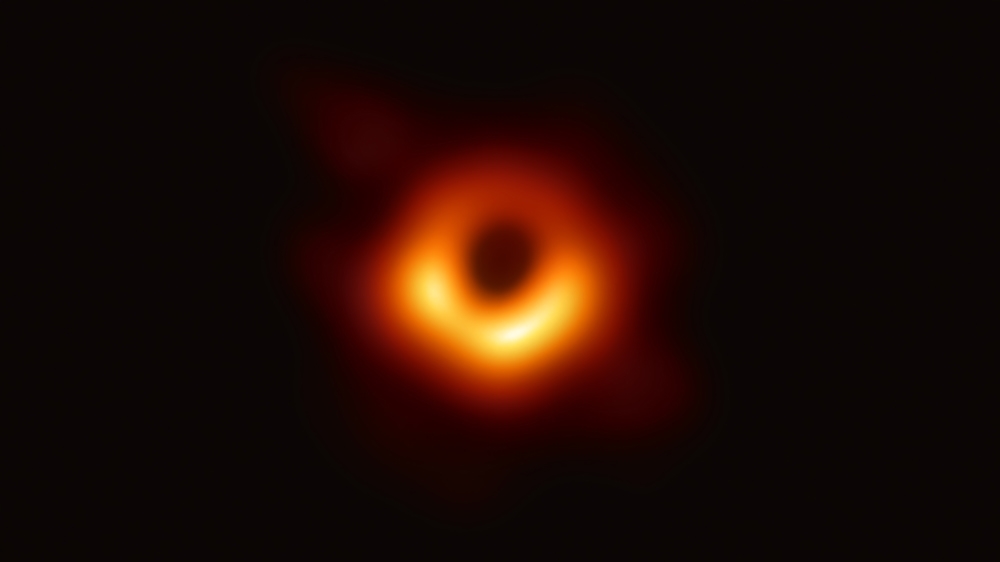
The very first picture of a black hole is here, finally.
In a major breakthrough, astronomers on Wednesday unveiled the highly anticipated image, which shows a dark core, encircled by a fiery orange halo of white-hot gas and plasma.
"You have probably seen many, many images of black holes before, but they were all simulations or animations. And this [image] is so precious to all of us because this one is finally real," Professor Heino Falcke of the Event Horizon Telescope (EHT), an international collaboration behind the image said at a news conference in Brussels.
A series of simultaneous press events were held around the world on Wednesday to share the announcement.
The supermassive black hole in the photo is 50m light-years away in a galaxy known as Messier 87 (M87). Capturing the image at such a distance is comparable to photographing a pebble on the surface of the Moon.
"It's a distance that we could have barely imagined," Frederic Gueth, an astronomer at France's National Centre for Scientific Research (CNRS) and co-author of the studies detailing the findings told AFP news agency.
The unprecedented photo - so often imagined in science and science fiction - has been analysed in six studies co-authored by 200 experts from 60-odd institutions and published on Wednesday in Astrophysical Journal Letters.
'Seeing the unseeable'
No single telescope is powerful enough to capture an image of a black hole, one of the star-devouring entities scattered throughout the universe and obscured by impenetrable shields of gravity.
Thus, over several days in April 2017, eight radio telescopes in Hawaii, Arizona, Spain, Mexico, Chile and the South Pole zeroed in on M87 as well as Sagittarius A*, the black hole at the centre of the Milky Way, the galaxy that contains Earth.
Researchers said that Sagittarius A* was too "active" to capture a clear picture, but the M87 black hole - which measures 40bn kilometres across - was more photogenic.
Though the telescopic data was gathered two years ago, completing the image took time due to the massive undertaking of delivering hundreds of terabytes of data - too much information to travel on the internet - worldwide by plane.
"We have achieved something presumed to be impossible just a generation ago," astrophysicist Sheperd Doeleman, director of the EHT at the Centre for Astrophysics, Harvard & Smithsonian said.
"We have seen what we thought was unseeable".
NASA described the image as a "historic feat" in a Twitter post, while scientists not involved in the EHT have suggested the achievement could be worthy of a Nobel Prize.
Adding weight to a century-old theory
Iconic physicist Albert Einstein first theorised the existence of black holes in his 1915 theory of general relativity but thought the idea was too outlandish to exist in reality.
Since then, the confounding entities have been studied by scientists around the world, including most prominently, by the late British theoretical physicist Stephen Hawking.
David Sobral, an astrophysicist at Lancaster University, told Al Jazeera that imaging the supermassive black hole was an "enormous achievement" for humankind.
"It completely confirms our idea that black holes really do exist and now the next step is we can start doing physics with it. We can really start to test the predictions and perhaps learn something new," he said.
Unlike smaller black holes that come from collapsed stars, supermassive black holes like the one in the image released on Wednesday are mysterious in origin. Situated at the centre of most galaxies, they are so dense that nothing, not even light, can escape their gravitational pull.
The fact that no light can escape makes viewing black holes difficult. The EHT scientists were looking for what is known as the black hole's shadow or silhouette - disrupted matter and radiation circling at tremendous speed at the edge of the event horizon - in order to capture an image.
The black hole featured in the now-famous photograph has an event horizon - the area around it where light and matter begin to fall inexorably into the hole - as big as our entire solar system.
Astrophysicist Dimitrios Psaltis of the University of Arizona, an EHT project scientist, said "the size and shape of the shadow matches the precise predictions of Einstein's general theory of relativity, increasing our confidence in this century-old theory.
"Imaging a black hole is just the beginning of our effort to develop new tools that will enable us to interpret the massively complex data that nature gives us".







